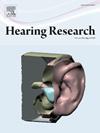正常听力者和人工耳蜗植入者在连续语音选择性注意范式中记录的音素相关电位。
IF 2.5
2区 医学
Q1 AUDIOLOGY & SPEECH-LANGUAGE PATHOLOGY
引用次数: 0
摘要
人工耳蜗可以恢复深度感音神经性听力损失患者理解语音的能力。目前,人们还不完全了解人工耳蜗使用者如何感知语音,以及人工耳蜗提供的电子听力与声学听力有何不同。音素相关电位描述了从连续语音中提取的单个音素实例的神经反应。这项回顾性研究在选择性注意范式中调查了人工耳蜗使用者的音素相关电位。比较了听力正常的听者和人工耳蜗植入者之间的反应,以及有注意和无注意条件下的反应。比较了不同音素类别之间的差异,并训练分类器从神经表征中预测音素类别。在早期反应(< 100 毫秒)中,人工耳蜗使用者的音素相关电位显示出与正常听力听者相似的反应,但在后期反应(> 100 毫秒)中,峰值变小或消失。注意力会增强反应,而潜伏期大多不受注意力的影响。反应的时间形态受刺激音素特征的影响,可根据音素相关电位对音素类别进行分类。临床上需要能快速、客观地评估人工耳蜗使用者言语理解能力的方法。音素相关电位可在音素的声学表征和神经表征之间提供这样一种联系。它们还能揭示个别受试者所面临的挑战,从而为针对患者的听觉训练、康复计划或人工耳蜗参数的匹配提供指示。本文章由计算机程序翻译,如有差异,请以英文原文为准。
Phoneme-related potentials recorded from normal hearing listeners and cochlear implant users in a selective attention paradigm to continuous speech
Cochlear implants can restore the ability to understand speech in patients with profound sensorineural hearing loss. At present, it is not fully understood how cochlear implant users perceive speech and how electric hearing provided by a cochlear implant differs from acoustic hearing. Phoneme-related potentials characterize neural responses to individual instances of phonemes extracted from continuous speech.
This retrospective study investigated phoneme-related potentials in cochlear implant users in a selective attention paradigm. Responses were compared between normal hearing listeners and cochlear implant users, and between attended and unattended conditions. Differences between phoneme categories were compared and a classifier was trained to predict the phoneme category from the neural representation.
The phoneme-related potentials of cochlear implant users showed similar responses to the ones obtained in normal hearing listeners for early responses (< 100 ms) but not for later responses (> 100 ms) where peaks were smaller or absent. Attention led to an enhancement of the response, whereas latency was mostly not affected by attention. The temporal morphology of the response was influenced by the phonetic features of the stimulus, allowing a classification of the phoneme category based on the phoneme-related potentials.
There is a clinical need for methods that can rapidly and objectively assess the speech understanding performance of cochlear implant users. Phoneme-related potentials may provide such a link between the acoustic and the neural representations of phonemes. They may also reveal the challenges of individual subjects and thus provide indications for patient-specific auditory training, rehabilitation programs or the fitting of cochlear implant parameters.
求助全文
通过发布文献求助,成功后即可免费获取论文全文。
去求助
来源期刊

Hearing Research
医学-耳鼻喉科学
CiteScore
5.30
自引率
14.30%
发文量
163
审稿时长
75 days
期刊介绍:
The aim of the journal is to provide a forum for papers concerned with basic peripheral and central auditory mechanisms. Emphasis is on experimental and clinical studies, but theoretical and methodological papers will also be considered. The journal publishes original research papers, review and mini- review articles, rapid communications, method/protocol and perspective articles.
Papers submitted should deal with auditory anatomy, physiology, psychophysics, imaging, modeling and behavioural studies in animals and humans, as well as hearing aids and cochlear implants. Papers dealing with the vestibular system are also considered for publication. Papers on comparative aspects of hearing and on effects of drugs and environmental contaminants on hearing function will also be considered. Clinical papers will be accepted when they contribute to the understanding of normal and pathological hearing functions.
 求助内容:
求助内容: 应助结果提醒方式:
应助结果提醒方式:


